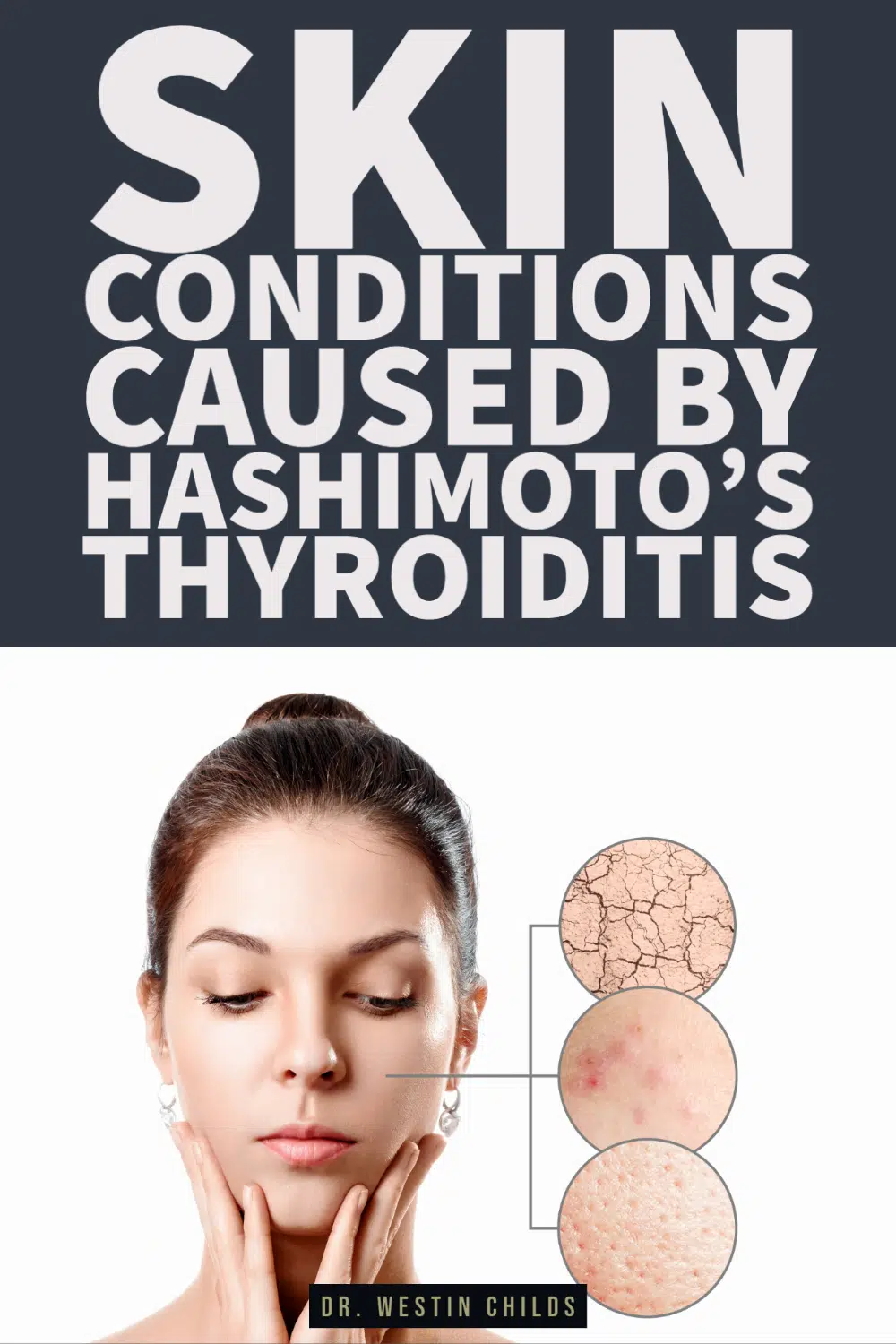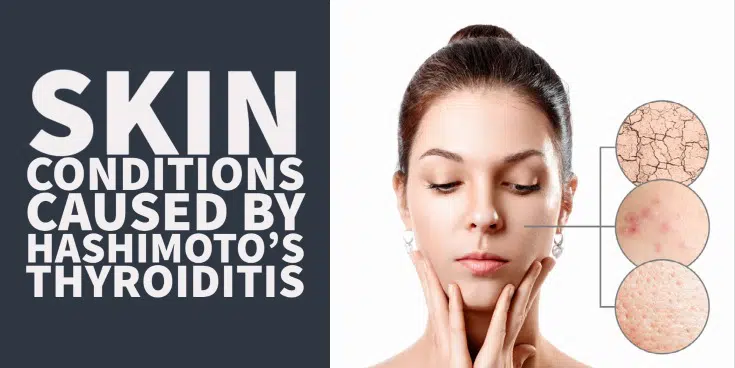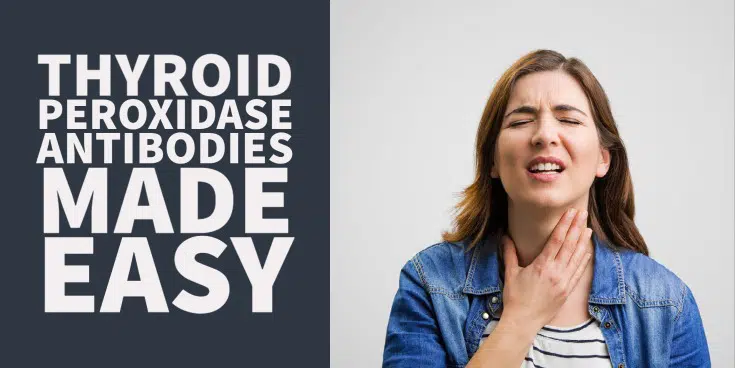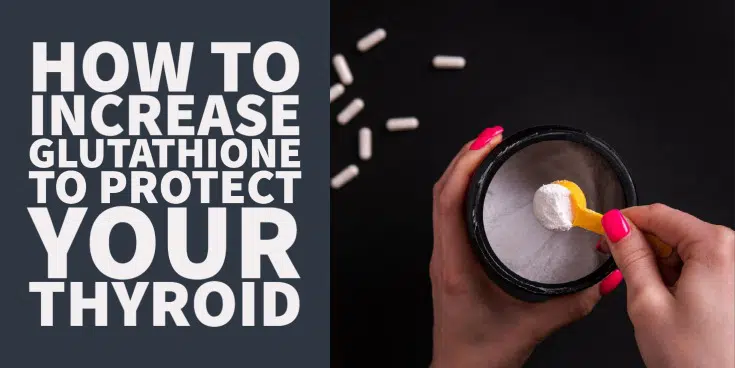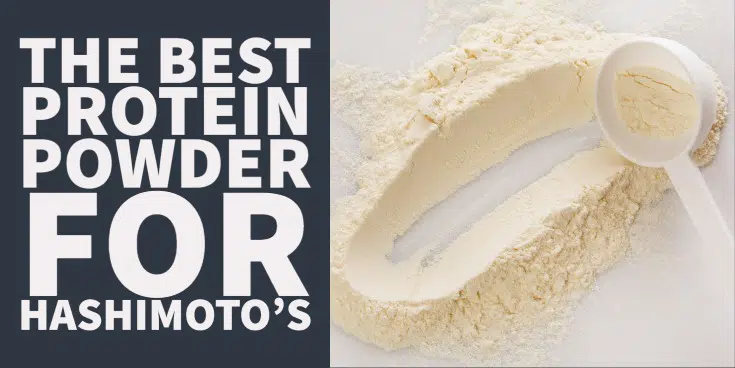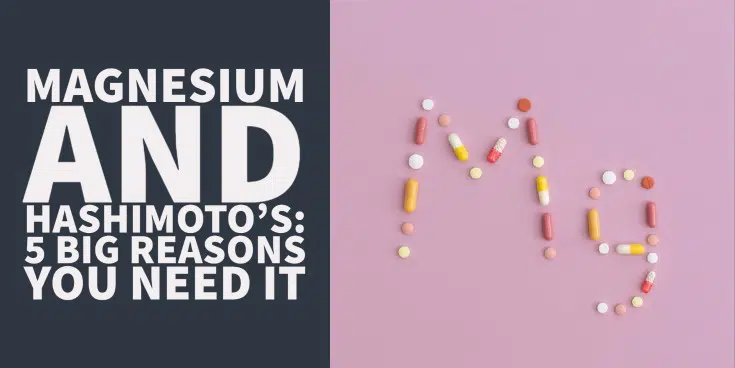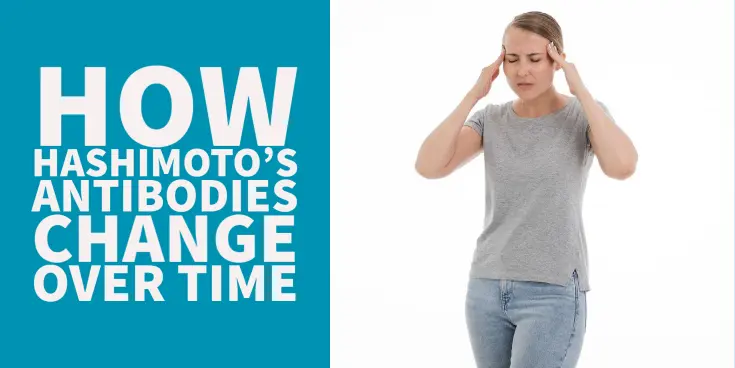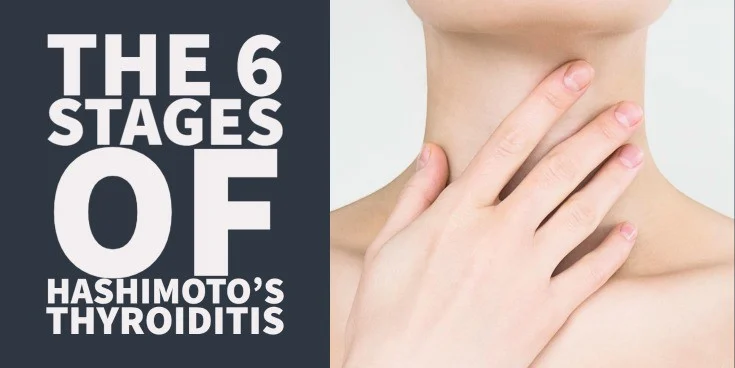Your skin is the largest organ on your body, and you should care a lot about the health of your skin for one very important reason:
It is an outward manifestation of inward health (1), and this includes your thyroid.
If you have problems with your skin, there’s a good chance you have problems with your thyroid.
Here are the most common skin conditions associated with thyroid conditions, including Hashimoto’s and hypothyroidism:
#1. Dry Skin
Dry skin is one of the most common symptoms of low thyroid (2), which can occur in hypothyroidism as well as Hashimoto’s thyroiditis.
It occurs in as much as 65% of patients with Hashimoto’s thyroiditis, which means that about 6 out of 10 people reading this may experience this symptom.
The medical term for dry skin is xerosis (3), and the type of dry skin that occurs in low thyroid states is different from that seen in other conditions.
Usually, this type of dry skin is seen on the extensor surfaces of the body, which means on the forearms, back of your hands, your back, and the back of your legs and shins.
If you are experiencing dry skin in these areas, then it may be due to your thyroid.
If you are experiencing dry skin in the winter months and it occurs all over your body, that’s most likely not related to your thyroid but instead related to the climate or weather.
#2. Thickening of the Skin
Thickening of the skin can also occur in Hashimoto’s, and the medical term for this is called hyperkeratosis (4).
Hyperkeratosis is more of a build-up of several layers of skin (more than normal), and it often occurs on the area of skin over your knuckles on the back of the hands and feet.
This thickening of the skin may also take on a different color and look different from the surrounding skin.
When you touch or feel it, it will feel thicker and different from how your skin normally feels.
#3. Hives (Urticaria)
Hashimoto’s also has the potential to trigger Hives in up to 6% of patients.
Hives, also known as urticaria, often indicate a problem with the immune system because hives are mediated by certain immune cells.
If you have Hashimoto’s and you are experiencing hives, then you will need to do some digging as to what is causing them.
Hives, in the setting of Hashimoto’s, can be caused by the following triggers:
- Food sensitivities
- Histamine intolerance
- Immune system dysregulation
- Inflammation
- Medications
- And exposure to fungal pathogens or mold
It appears that Hashimoto’s primes your body to be more susceptible to acquiring hives compared to the average population.
This means that coming into contact with things that wouldn’t normally cause hives may actually cause hives if you have Hashimoto’s.
You can learn more about finding the cause of hives as well as treatment options here if this is something that you struggle with.
#4. Large or Thickened Tongue (macroglossia)
This is a fairly uncommon sign of Hashimoto’s because it tends to occur later in the course of hypothyroidism.
Most people do not experience this symptom because they are able to get on thyroid medication before it becomes an issue, but it still can occur in some people.
Those people at risk for tongue enlargement (5) include people who are very resistant to thyroid medication or thyroid treatment.
These people have something called thyroid resistance, which can either be genetic (6) or it can be acquired at the cellular level.
This is not a common symptom, but it is included here for completeness!
#5. Rapid Aging & Collagen Loss
Many thyroid patients experience a rapid decline in the overall quality and texture of their skin within a few years of their diagnosis.
They notice this, but they don’t attribute it to their thyroid. Most just believe they are getting older.
And while that may be true, it’s also just as true that thyroid dysfunction accelerates collagen decline.
And collagen is the protein that keeps your skin looking healthy, young, plump, and firm.
You will never be able to completely stop collagen decline, but you better believe you can slow it down (and even reverse some of the decline that’s already happened).
And if you’re a thyroid patient who wants to look their best, the fastest way to do this is with collagen supplements.
Given how dramatic the decline in collagen can be with thyroid patients, my recommendation is to take 15-20 grams of collagen peptides daily.
This can help reverse some of that collagen decline that will occur even if your thyroid isn’t optimized, and it can also bring back a more youthful appearance to your skin in as little as 30 days of daily use.
You can get my recommended brand of collagen for thyroid patients here.
#6. Acne
Acne, on the other hand, is much more common than tongue-related issues!
There are many types of acne, and the acne associated with Hashimoto’s tends to be a deep cystic type of acne that occurs all over the face.
This is the type of acne that is typically seen in those with low thyroid function, but it’s not the only type of acne that you may experience if you have Hashimoto’s.
Hashimoto’s can also impact your sex hormone levels (including estrogen and progesterone) in a negative way.
If this occurs, then you may experience a hormonal pattern of acne that is predominant on the jawline as well as in the T zone of the forehead.
This hormonal pattern of acne is related to the thyroid as much as it is related to the impact that your thyroid has on estrogen and progesterone levels.
Both of these types of acne can be directly or indirectly associated with Hashimoto’s thyroiditis.
#7. Hair Loss
It may surprise you that hair loss makes the list, but remember, your hair follicles are embedded in your skin!
This means that your hair is really an extension of your skin, and problems of the skin can manifest as problems with your hair.
Hair loss is very common and can occur in as much as 76% of thyroid patients, depending on which study you look at.
In other words, there is about a 7 out of 10 chance that if you are reading this, your hair may be impacted by your thyroid!
There are many types of hair loss, but 3 specific patterns that Hashimoto’s can cause.
These patterns include:
- Diffuse hair loss (This is the most common type of hair loss in Hashimoto’s) – This refers to hair loss over your ENTIRE head. People with this type of hair loss usually notice hair loss in the shower, extra hair falling out on their pillow, and an overall thinning of their hair over time.
- Androgenetic alopecia (7) – This type of hair loss usually occurs on the temples and on the crown of the head and is usually associated with changes in testosterone levels (similar to the way that hormone problems can cause acne as well).
- Alopecia areata (8) – This is an autoimmune type of hair loss that occurs in discrete patches or circles on your head. It is primarily mediated through an autoimmune response, which means it can be difficult to treat.
People with Hashimoto’s can experience any of these types of hair loss, though the diffuse pattern of hair loss is definitely the most common!
You can learn more about hair loss associated with Hashimoto’s and how to treat it here.
#8. Eyebrow Hair Loss
Eyebrow hair loss is another specific type of hair loss that those with Hashimoto’s may experience.
This type of hair loss is actually a very useful sign as well!
It is one of the first signs that indicate you have a low thyroid state, and it usually occurs on the lateral one-third of the eyebrow or on the tail of the eyebrow.
If you can imagine splitting your eyebrow into thirds, then this hair loss would occur on the last 1/3 of the eyebrow (9), which is closest to your temple.
It is a very sensitive sign of Hashimoto’s, and it can be used as a diagnostic tool if you aren’t sure what is going on with your thyroid!

It can also be helpful in figuring out if whatever treatments you are using are working.
If you start taking thyroid medication, for instance, one way to know if that medication is working is by looking at your eyebrow hair.
If it’s not growing back after several months, then that may be an indication that you need to adjust your dose or recheck your thyroid lab tests.
This occurs in both hypothyroidism and Hashimoto’s thyroiditis.
#9. Pale or Discolored Skin in the Extremities
This symptom goes along with cold intolerance that many patients with Hashimoto’s may experience.
Low thyroid states can result in decreased or diminished blood flow to your extremities as well as decreased heat production in the same.
Thyroid hormone has a big impact on your basal metabolic rate (how many calories you burn) as well as your general body temperature.
In addition, it also impacts blood flow by affecting how quickly or slowly your heart beats.
If you imagine for a second that a low thyroid state slows down your heart, slows down energy and heat production, and slows down blood flow, then you can easily see how it can impact your extremities.
Think of it this way:
What happens when you are outside in the middle of winter and covered in snow?
Your body shunts blood to your core, which leaves less blood flow in your hands and feet.
Your hands and feet then become a pale blue, and they become very cold.
This exact same thing happens to thyroid patients, but it can happen in the summer!
It isn’t a problem of the skin so much as it is a problem with your blood vessels, blood flow, and energy production, though.
#10. Facial Swelling
Facial swelling is another concerning symptom related to low thyroid function and Hashimoto’s!
Facial swelling can be all over the face, but is usually around the eyes.
Some people will describe this as having “puffy” eyes.
This symptom occurs in about 38% of people, which means about 1 out of every 3 patients with Hashimoto’s may experience it.
Facial swelling (10) (or edema) usually is worse in the morning, right when you wake up, and decreases or improves throughout the day.
The reason it improves throughout the day is that, as you wake up and walk around, gravity is helping to pull that swelling back into your body and put it back into circulation.
You can manage this symptom by sleeping with a cold compress over your eyes, getting a facial massage, or improving thyroid function with thyroid medication or thyroid supplements.
#11. Dermatitis Herpetiformis
A couple of the skin conditions coming up are not directly related to Hashimoto’s, but they are often associated with this disease state, which is why they are included.
A perfect example of this is dermatitis herpetiformis.
This is the skin condition associated with Celiac disease (not Hashimoto’s).
Why is it included here?
Because about 5-8% of patients with Hashimoto’s will ALSO have Celiac disease, which is anywhere from about 1 in 20 patients to 1 in 12 patients.
Dermatitis herpetiformis results in groups of blisters and bumps (11) that are very itchy.
It’s given the name herpetiformis because the lesions look very similar to the lesions caused by herpes (hence the name!).
If you are someone who has Hashimoto’s and you are experiencing itchy skin with blisters and bumps, then it would be a very good idea to get tested for Celiac disease.
You may even want to consider just going gluten-free regardless of your Celiac status for the reasons listed here.
#12. Vitiligo
Another example of a skin condition associated WITH Hashimoto’s (12) but not caused BY Hashimoto’s is vitiligo.
Vitiligo, like Hashimoto’s, is another autoimmune disease and can occur in about 6% of thyroid patients.
That means about 6% of patients with Hashimoto’s will ALSO have vitiligo.
Vitiligo is an autoimmune disease that results in depigmentation of the skin.
In this autoimmune disease, your immune system attacks your melanocytes, which are responsible for giving your skin its pigment.
If your melanocytes are destroyed, they are unable to produce pigment to match the color of your surrounding skin, and you will start to experience white or pale spots on your body.
These spots are usually symmetrical on the body, meaning if you have them on one side of your body or face, you usually have them on the other side as well.
#13. Weak or Atrophied Fingernails
This is a little bit strange, but you can easily test for it.
If you take the index finger of your left hand and press against the fingernail of your right index finger, you should feel a firmness to the fingernail.
There will be a slight give to your fingernail, but it should still be firm.
If you press on your fingernail and it appears flimsy or bends quite a bit, then you know there is an issue, and that’s what we are talking about here.
Your fingernails are impacted by thyroid function much in the same way that your hair follicles can be.
This can be either directly through the thyroid’s impact on your nails or indirectly through its impact on the absorption of certain nutrients.
Weak or brittle fingernails can usually be managed by taking certain supplements, such as choline or silica.
If you’re a thyroid patient, you’ll want to use the most bioavailable form of silicon known as MMST.
Take it daily for 60 days and you should see an improvement in the texture and quality of your nails.
#14. Decreased Sweating
Because the thyroid helps to regulate the sweating mechanism, low thyroid states result in decreased sweating of the body.
This may not sound like a bad thing at first, until you realize that sweating is one of the main ways that your body eliminates toxins.
Because sweating is so important for detoxification purposes, it makes sense that those who can’t sweat will accumulate some of these toxins inside their body.
And this is exactly what happens with thyroid patients and those with Hashimoto’s.
The good news is that you can force your body to sweat (without the need for exercise) using therapies such as FAR IR saunas.
FAR IR saunas help to heat up your body, activate heat shock proteins, enhance detoxification, and force your body to sweat.
Saunas are great therapies for those with Hashimoto’s for their benefits of detoxification, but also for their benefits on skin health more generally.
The IR rays found inside the sauna can improve skin health directly, reduce inflammation, and help with some skin conditions, such as acne.
#15. Fungal Infections of the Skin
I’m not talking about serious skin infections here, but instead, the more annoying low-grade red rashes/fungal infections that can occur in your skin folds.
Because patients with Hashimoto’s have a weakened immune system, they are more likely to develop fungal skin infections.
They are usually easy to treat with topical anti-fungal creams, and they can be prevented by improving immune function.
#16. Psoriasis
Last, we have psoriasis.
There seems to be an association between psoriasis and Hashimoto’s, but how and why it occurs is not clear.
We just know that patients who have psoriasis also tend to have a higher risk of developing thyroid antibodies and experiencing thyroid gland inflammation.
My experience suggests that while the connection does exist, it’s not as common as some of the other autoimmune diseases I’ve mentioned above.
I wanted to bring it up, though, because I have seen a handful of patients who have Hashimoto’s who experience nail-related psoriasis, which is difficult to diagnose.
These patients have a mild case of psoriasis that impacts only their nails, leaving ridges and bumps in the nail bend, which often gets ignored or glossed over by other physicians.
If you are experiencing continued nail problems AND you have Hashimoto’s, then this would be something to consider!
Your Next Steps
The most important thing to remember about this article is the connection that your thyroid has with the overall health of your skin.
Many different types of skin conditions can be caused either directly or indirectly by your thyroid gland, and not all of them are obvious.
The good news is that as you manage your Hashimoto’s, you should see improvement in the overall health of your skin.
Here are some strategies to help you do just that:
- Optimize thyroid function – You can do this by either aggressively using natural therapies to improve your Hashimoto’s or by using thyroid medication. Both can work!
- Heal your gut – There is a strong connection between your gut health and the health of your skin. If you are having skin issues, then make sure to look for problems in your gut as well.
- Try different diets – The food you put into your mouth also has an impact on your skin health. I’ve found that the elimination diet is particularly useful for treating stubborn skin issues. Other diets, such as whole30 and paleo can also work, though.
- Purchase cleaner beauty products – Lastly, make sure that you aren’t irritating your skin or causing issues for your thyroid by putting chemicals on your skin! Beauty products are notorious for containing chemicals and ingredients that can cause thyroid problems. You can find clean beauty products using the database at ewg.org.
Now I want to hear from you!
Are you experiencing any of the skin conditions listed above?
Did your condition(s) start after you were diagnosed with Hashimoto’s?
Have you had any success in improving your skin health by treating your thyroid?
Are you planning on trying any new therapies to help improve your skin health?
Leave your questions or comments below!
Scientific References
#1. https://pubmed.ncbi.nlm.nih.gov/19932330/
#2. https://www.aad.org/public/diseases/a-z/thyroid-disease-skin-changes
#3. https://www.mountsinai.org/health-library/diseases-conditions/xerosis
#4. https://www.ncbi.nlm.nih.gov/pmc/articles/PMC3371544/
#5. https://www.ncbi.nlm.nih.gov/pmc/articles/PMC3169868/
#6. https://www.ncbi.nlm.nih.gov/pmc/articles/PMC4790576/
#7. https://www.ncbi.nlm.nih.gov/pmc/articles/PMC3746235/
#8. https://www.ncbi.nlm.nih.gov/pmc/articles/PMC4931647/
#9. https://www.ncbi.nlm.nih.gov/pmc/articles/PMC3358936/
#10. https://pubmed.ncbi.nlm.nih.gov/11888493/
#11. https://celiac.org/about-celiac-disease/related-conditions/dermatitis-herpetiformis/
#12. https://pubmed.ncbi.nlm.nih.gov/31203913/
